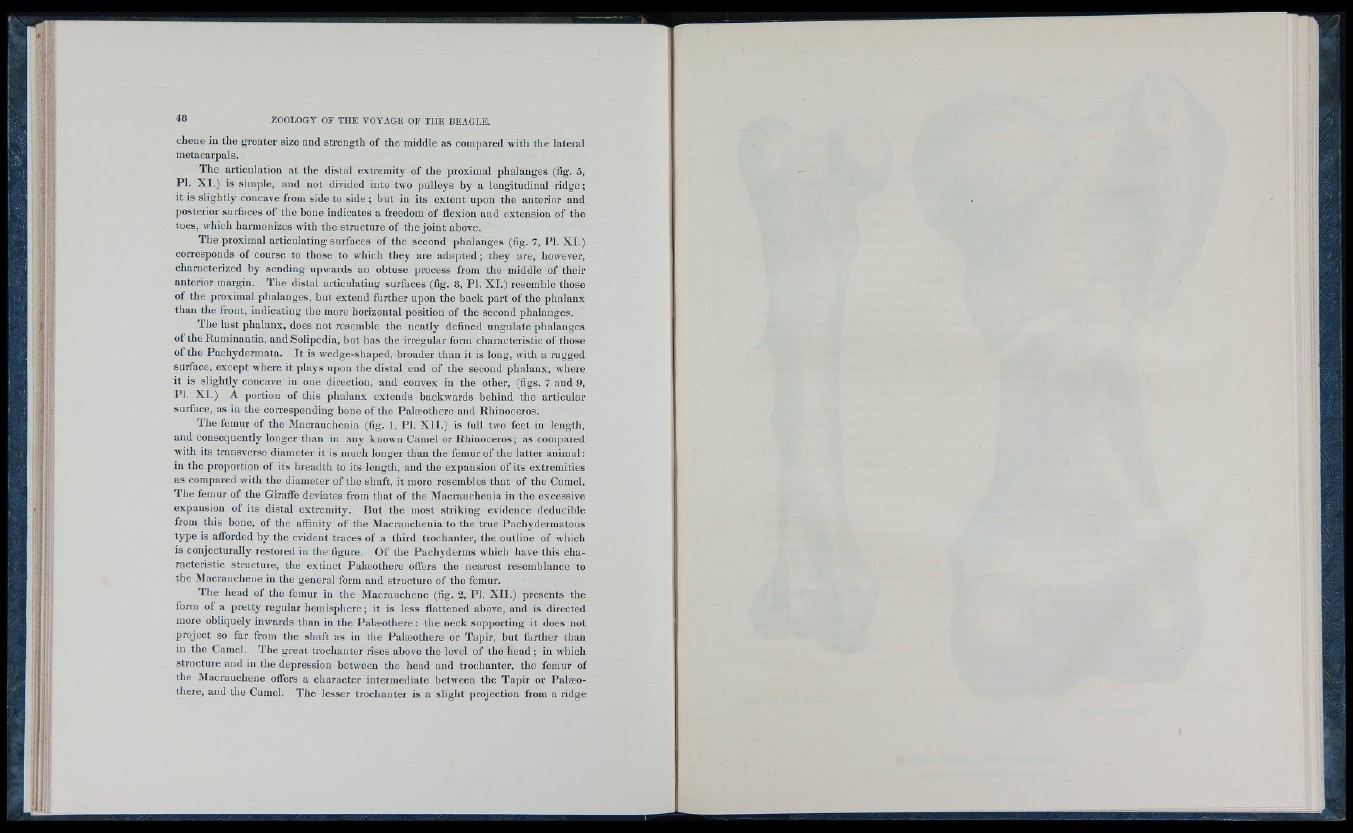
cliene in the greater size and strength o f the middle as compared with the lateral
metacarpals.
The articulation at the distal extremity o f the proximal phalanges (fig. 5 ,
PI. X I .) is simple, and not divided into two pulleys by a longitudinal ridge;
It is sligh tly concave from side to side ; but in its ex ten t upon the anterior and
posterior surfaces o f the bone indicates a freedom o f flexion and extension o f the
to es, which harmonizes with the structure o f the joint above.
The proximal articulating surfaces o f the second phalanges (fig. 7, PI. X I .)
corresponds o f course to those to which they are adapted ; they are, however,
characterized by sending upwards an obtuse process from the middle o f their
anterior margin. The distal articulating surfaces (fig. 8 , PI. X I .) resemble those
o f the proximal phalanges, but extend further upon the back part o f the phalanx
than the front, indicating the more horizontal position o f the second phalanges.
The la st phalanx, does not resemble the neatly defined ungulate phalanges
o f the Ruminantia, and Solipedia, but has the irregular form characteristic o f those
o f the Pachydermata. It is wedge-shaped, broader than it is long, with a rugged
surface, ex c ep t where it pla y s upon the distal end o f the second phalanx, where
it is sligh tly concave in one direction, and convex in the other, (figs. 7 and 9 ,
PI. X I .) A portion o f this phalanx extends backwards behind the articular
surface, as in the corresponding bone o f the Palæothere and Rhinoceros.
The femur o f the Macrauchenia (fig. 1, P i. X I I .) is full two feet in length,
and consequently longer than in any known Camel or Rhinoceros; as compared
with its transverse diameter it is much longer than the femur o f the latter animal :
in the proportion o f its breadth to its length, and the expansion o f its extremities
as compared with the diameter o f the shaft, it more resembles that o f the Camel.
The femur o f the Giraffe deviates from that o f the Macrauchenia in the ex c essiv e
expansion o f its distal extremity. B u t the most striking evidence deducible
from this bone, o f the affinity o f the Macrauchenia to the true Pachydermatous
type is afforded by the evident traces o f a third trochanter, the outline o f which
IS conjecturally restored in the figure. O f the Pachyderms which have this characteristic
structure, the ex tinc t Palæothere offers the nearest resemblance to
the Macrauchene in the general form and structure o f the femur.
Th e head o f the femur in the Macrauchene (fig. 2 , PI. X II .) presents the
form o f a pretty regular hemisphere; it is le ss flattened above, and is directed
more obliquely inwards than in the Palæothere ; the neck supporting it does not
project so far from the shaft as in the Palæothere or Tapir, but farther than
in the Camel. The great trochanter rises above the level o f the head ; in which
structure and in the depression between the head and trochanter, the femur of
the Macrauchene offers a character intermediate between the Tapir or Palæothere,
and the Camel. The lesser trochanter is a sligh t projection from a ridge
n .